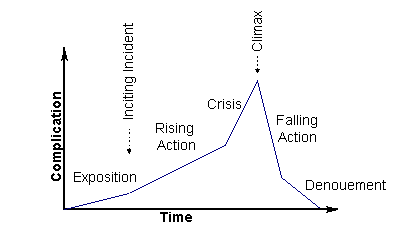
LEARNING RESOURCES
TITLE MUSIC
Compose Music for the intro of a film or TV show - Any Genre
EDM MUSIC
Compose Music for the the DJ students. Dance Music of any genre.
AMBIENT MUSIC
Compose chilled out music. for the new BBA Spa. - Can also be used for underscores for folm
HIP HOP
Compose the Music for a Hip Hop song and find an audio engineer to record the rap.
FOUND SOUNDS
Record sounds from the environment and turn them into a song
BUILDING YOUR EARS
BUILDING YOUR EARS
THE STORY ARC
There is a symbiotic relationship between a story's action and the music that accompanies it. To know how to best score music for film, one must be completely aware of the dramatic structure of the story. The Freytag Pyramid is one tool to explore this relationship.


The Second Graphic introduces the concept of time to the process with rising complication or tension.
Freytag's Pyramid: Five Dramatic Structures
Open in full view
Gustav Freytag, a German novelist and critic of the nineteenth century, observed the similarity of plots so he created a pictorial tool to visually illustrate dramatic structure. Called Freytag’s Pyramid, he constructed a pattern in the form of a pyramid to analyze the plot structure of dramas.
Freytag referred to the five dramatic structures as the five dramatic arcs:
1. Exposition or Introduction
The exposition/introduction presents the setting (time and place), characters (protagonist – hero/heroine, antagonist – villain), and the basic conflict; it also establishes the mood or atmosphere of the story. The first dramatic arc enables the reader to know more about the circumstances and the relationship of the characters with each other. Then an exciting event happens leading to the conflict which impels the story to move forward. In the drama, the exposition starts in the first paragraph as Act I/ Scene 1; the circumstances may be stated in a narration. In the pyramid, arc 1 is at the lowest left part.
2. Rising action
Rising action is the second arc where the basic conflict is brewing and the reader is beginning to feel the rising tension associated with this conflict. At this juncture, the basic conflict is further complicated by the introduction of obstacles frustrating the protagonist and other characters to reach their objectives. Secondary conflicts are probably coming from the antagonist, or adversaries, of lesser importance. In a dramatic structure, rising action is another act/scene and punctuated to be distinct from the climax. In the pyramid, rising action is located in the middle left portion just above the exposition and below the climax.
3.Climax
The climax is the turning point and this third arc effects a change either for the better or for the worse in the protagonist’s situation. In a comedy, the protagonist positively faces his obstacles and there is a great chance that things will turn out well; but in a tragedy, the conflict of the protagonist is worsening which will ultimately turn disastrous for him. The climax is the beginning of another act/scene and punctuated to separate it from the rising and falling action. It occupies the highest point in the pyramid.
4. Falling action
A reversal happens in this fourth arc where the conflict between the protagonist and the antagonist is beginning to resolve. The protagonist either wins or loses to the antagonist. There are unexpected incidents which make the final outcome suspenseful. The falling action designates that the main action (the climax) is over and the story is heading towards the end. This fourth arc is located at the middle right side of the triangle just below the climax and above the conclusion. It appears as a separate act/scene and is distinct from the other arcs.
5. Conclusion
The conclusion is the end of the story which is sometimes called dénouement, resolution, or catastrophe. If at the end of the story the protagonist achieves his goal, the story is a comedy; however, if the protagonist fails, the story is a tragedy. After conflicts are resolved, the characters resume their normal lives. The conclusion makes way for the catharsis - an event or events allowing the tension or anxiety to loosen. The denouement is an event that happened before or after the conclusion or is simply explained as untying the complexities of the plot. The conclusion is found at the lowest right side of the pyramid following the falling action. It is the beginning of another act/scene and punctuated as distinct from the other parts of the dramatic structure.
Sometimes, modern works do not have a dénouement for endings that are abrupt. In the novels, Harry Potter and the Deathly Hallows (2007) and The Return of the King (1955), the denouement are quite long as they reveal what happens to the protagonists after the story's conclusion.

Here is your Challenge:
Using the "Wizard of Oz" as your source, plot Freytag's stages of dramatic development in this famous story. Determine the seven different stages and plot them on a graph of your own creation. Once completed, analyze the song selections used in the story and reflect on how the music compliments the rise and fall of action. Add the musical reflection to your graphic analysis.
Some tools to Help:
Post your result in your portfolio.




.png)
![[removal.ai]_6fdc33e9-0532-4bd9-9ddb-48b370945529.png](https://static.wixstatic.com/media/81014d_cbf6a3f5718645f79592b100cfc60da1~mv2.png/v1/fill/w_239,h_53,al_c,q_85,usm_0.66_1.00_0.01,enc_auto/%5Bremoval_ai%5D_6fdc33e9-0532-4bd9-9ddb-48b370945529.png)